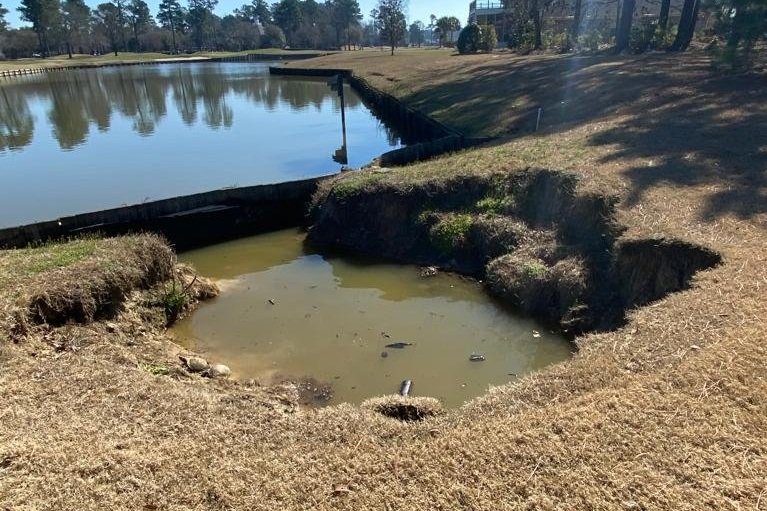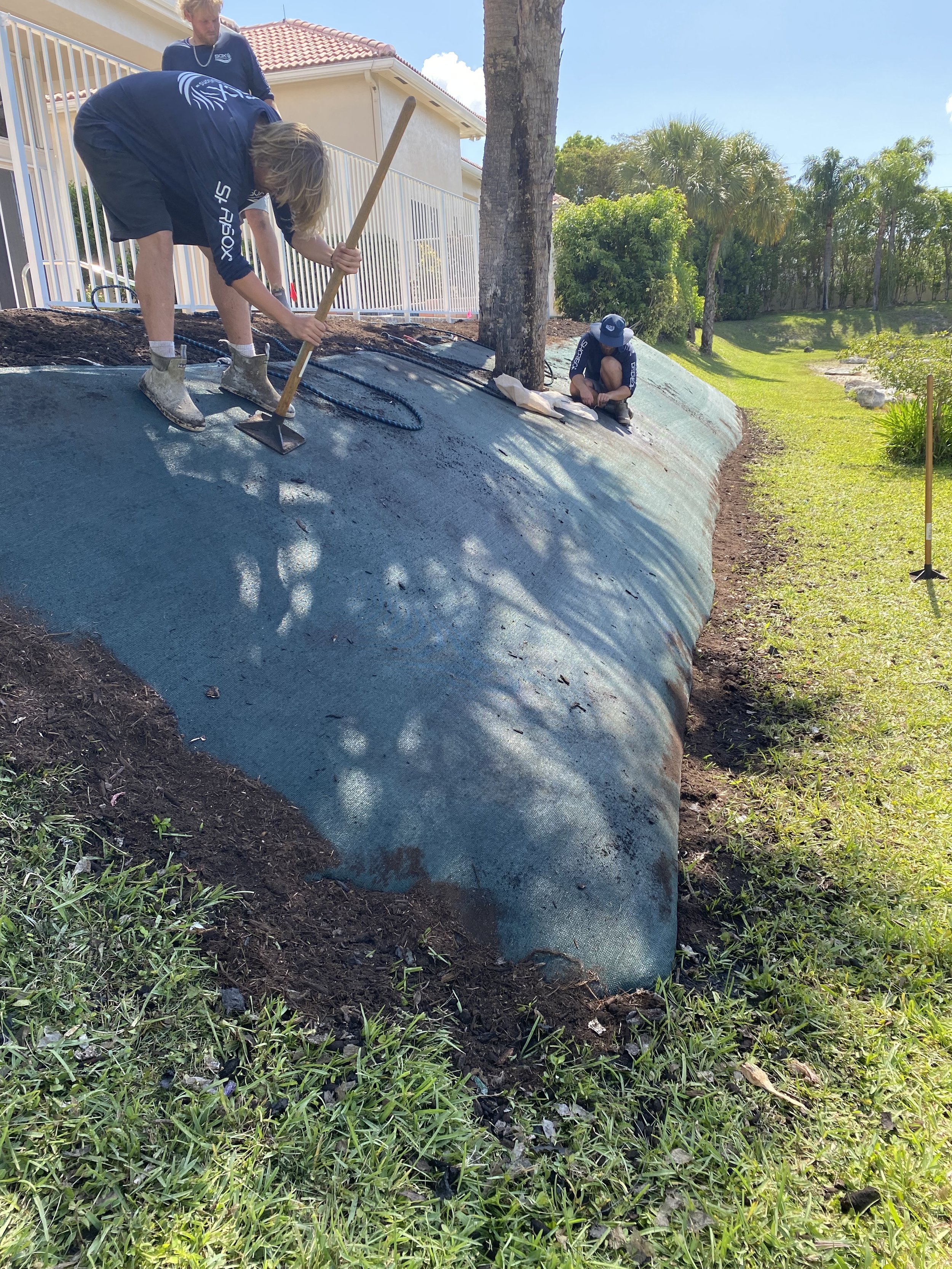What is erosion and how can it be managed?
What is Erosion?
Erosion control is an important phenomenon. It is a naturally occurring process but when left alone in developed areas it can cause serious issues for nearby infrastructure. In order to prevent or mitigate erosion(erosion control) it is important to first understand erosion and its driving factors. Once understanding the many specific variables of erosion you can then begin to identify proper erosion control methods for your unique scenario.
National Geographic defines erosion as “the geological process in which earthen materials are worn away and transported by natural forces such as wind or water.” One of the most common places erosion is seen is on unvegetated beaches and dunes. The loose sediment in these places is unstable and exposed to the elements. For this reason the sediment is easily transported and worn away. Many coastal towns and cities are experiencing property loss because of the high susceptibility of these areas to erosion.
What is erosion control?
For the readers who already understand what erosion is and are possibly experiencing it, it can be useful to understand the many methods for preventing it. The many methods of erosion control can be separated into two main categories: Hard armored erosion control solutions, and soft armored erosion control solutions. Hard armored erosion control solutions include things like jetties, groins, seawalls, bulkheads, gabion baskets, and rip-rap. Examples of soft armored erosion control solutions are geotextiles, and non-structural vegetative restorations.
Hard armored erosion control solutions:
Hard armored erosion control solutions were the primary method for erosion control for many years. This is why you see many jetties, seawalls, and rip-rap structures being used for erosion control on the oldest cities and beaches. People believed that the stronger the structure the better equipped that structure would be to combat the powerful forces of erosion. Scientists have recently found that hard structures are actually an inferior method of erosion control that can cause damage to the environment. Although hard structures may prevent erosion in certain areas in the short term, they actually cause increased erosion in unintended areas in the long term. For example, take a look at jetties as an erosion control method. Jetties are one of the most common forms of erosion control and can be seen on almost all beaches throughout the United states. To understand the issues caused by this hard armored erosion control solution it is important to first understand how they work. Every coastal beach has a process called a longshore current. A longshore current is a current that runs parallel to the beach. As it runs along the beach it transports sediment from the beach up river to down river. When a jetty is placed adjacent to the beach it disrupts this longshore current and sediment transport. The jetty begins to collect the sediment being transported and the up river side of the beach begins to build up. This sounds great but the problem is the beaches down river then lose the sediment replenishment of the longshore current and begin to erode away at higher rates. This is why often where there is one jetty there are many. When one area's beachfront begins to erode away due to an upriver jetty the only solution is for the area to build its own jetty. This only causes a larger problem for the next area down river and the process continues. The erosion problem iis never solved, just pushed onto the next area. The disruption of natural processes such as longshore current for erosion control can also be extremely detrimental to the environment. The construction of these structures use large machinery that can trample terrestrial and aquatic habitat. Also the disruption of natural processes can cause imbalances in local ecosystems. For these reasons hard armored erosion control solutions have been outlawed in many areas.
Soft armored erosion control solutions:
Soft armored erosion control solutions are the alternative to hard armored erosion control solutions. These solutions use work to enhance the natural environment. Many aquatic plants have evolved to have deep entangled root structures in order to survive in harsh and high energy environments. These deep entangled root structures subsequently stabilize sediment and act as a natural barrier to erosion. Unfortunately many of these shoreline plant habitats have been trampled and destroyed by development. This is another major factor contributing to erosion.
Soft armored structures act to restore natural habitats. Some soft armored erosion control solutions use only vegetation. When this works it is a great solution with positive environmental impact. The problem with only using vegetation for erosion control is that the vegetation takes time to establish its roots in the sediment. In high energy environments like coastal beaches the vegetation can be washed away and destroyed before it has time to take root. For this reason it is best to implement some sort of geotextile in your soft armored erosion control solution. Geotextiles will encapsulate the loose sediment and give roots the chance to establish themselves. It is important to do your research when picking the write geotextile for erosion control. Some geotextiles like GEOTUBE use woven material that does not let vegetation grow through. If vegetation cannot establish itself within the geotextile then the system will not integrate with the existing shoreline causing problems down the road. Click here for the erosion control solutions we recommend.
The best geotextiles are knitted. Knitted geotextiles feature a series of individual knots. If one of these knots is ripped it does not compromise the rest of the system of knots. When a woven geotextile is ripped it will get worse and worse over time as it unravels like a pair of panthose. Knitted geotextiles prevent ripping and compromising of the erosion control system. These geotextiles will also allow the system to dewater. This dewatering affect not seen in hard armored erosion control solutions will help to filter nutrients before entering adjacent water bodies. Excess nutrients from things like lawn fertilizer can be detrimental to aquatic environments. These excess nutrients can lead to algal blooms and eutrophication that is not only ugly but can also cause depleted dissolved oxygen in the water leading to dead zones and fish kills. These are just a few of the many reasons why soft armored erosion control systems are superior to hard armored structures.
How to control erosion on a hill.
Hillside erosion is very similar to shoreline erosion. The only difference is the transport of sediment is not caused by waves, rivers, and currents but instead by wind and rainfall. Other natural processes like wildfires can amplify these problems by destroying vegetation stabilizing these hillsides. Because of the steepness of hills, erosion can be very severe and can worsen quickly. For this reason it is important to address hillside erosion as soon as you notice the problem.
Solutions for hillside erosion are similar to those of shoreline erosion. Again the best erosion control methods for hillside erosion are soft armored erosion control solutions. A typical hillside erosion control system that is often used is rip-rap. This hard armored erosion control solution can be extremely costly and requires constant maintenance. A better solution is to use methods like erosion control fencing. This method helps to collect sediment as it makes its way down slope. The backside of these fences can be vegetated so that loose sediment is stabilized when collected. The most common erosion control fencing is silt fencing. This solution is extremely cheap but it is not very durable and most importantly does not dewater. For this reason the silt fencing can be easily washed away and destroyed leading to maintenance and unnecessary repairs.



